 W
WApproach angle is the maximum angle of a ramp onto which a vehicle can climb from a horizontal plane without interference. It is defined as the angle between the ground and the line drawn between the front tire and the lowest-hanging part of the vehicle at the front overhang. Departure angle is its counterpart at the rear of the vehicle – the maximum ramp angle from which the car can descend without damage. Approach and departure angles are also referred to as ramp angles.
 W
WThe drag coefficient is a common measure in automotive design as it pertains to aerodynamics. Drag is a force that acts parallel to and in the same direction as the airflow. The drag coefficient of an automobile measures the way the automobile passes through the surrounding air. When automobile companies design a new vehicle they take into consideration the automobile drag coefficient in addition to the other performance characteristics. Aerodynamic drag increases with the square of speed; therefore it becomes critically important at higher speeds. Reducing the drag coefficient in an automobile improves the performance of the vehicle as it pertains to speed and fuel efficiency. There are many different ways to reduce the drag of a vehicle. A common way to measure the drag of the vehicle is through the drag area.
 W
WAutomotive aerodynamics is the study of the aerodynamics of road vehicles. Its main goals are reducing drag and wind noise, minimizing noise emission, and preventing undesired lift forces and other causes of aerodynamic instability at high speeds. Air is also considered a fluid in this case. For some classes of racing vehicles, it may also be important to produce downforce to improve traction and thus cornering abilities.
 W
WThe axle track in automobiles and other wheeled vehicles which have two or more wheels on an axle, is the distance between the centerline of two roadwheels on the same axle. In a case of the axle with dual wheels, the centerline in the middle of the dual wheel is used for the axle track specification.
 W
WBody in white (BIW) is the stage in automobile manufacturing in which a car body's frame has been joined together, that is before painting and before the motor, chassis sub-assemblies, or trim have been integrated into the structure. Assembly involves different techniques such as welding, riveting, clinching, bonding and laser brazing.
 W
WBreakover angle is the maximum possible supplementary angle that a vehicle, with at least one forward wheel and one rear wheel, can drive over without the apex of that angle touching any point of the vehicle other than the wheels. This definition is contingent upon the wheels being in continuous contact with the supporting surface(s). Breakover angle differs from ground clearance, which is the shortest distance between the ground and lowest point on the vehicle.
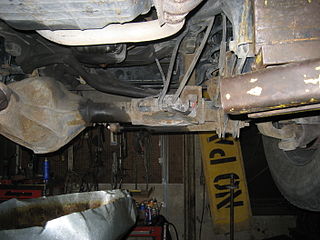 W
WA center axle disconnect system or CAD is an alternative to locking hubs. CAD systems are typically used in front drive axles on four wheel drive vehicles. A CAD system works by having an axle shaft split into two pieces. One piece is connected to the carrier, the other connected to the wheel. This reduces drag on the axle by allowing only the spider and side gears to spin, while the differential carrier, pinion and drive shaft are at rest. The axle is engaged by connecting the two split axle shafts. The ends of the axles are typically splined and use a collar to connect the two shafts together by sliding over both shafts.
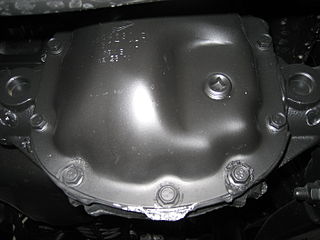 W
WThe Dana/Spicer Model 30 is an automotive axle manufactured by Dana Holding Corporation. It has been manufactured as a beam axle and independent suspension axle with several versions.
 W
WThe Dana/Spicer Model 35 is an automotive axle manufactured by Dana Holding Corporation since 1985 when American Motors (AMC) sold its axle tooling equipment to Dana. The axle was originally named an AMC-15 when it was first made in 1962. Dana upgraded the axle, and made IFS and Twin Traction Beam front axle variations, as well.
 W
WThe Dana/Spicer Model 44 is an automotive axle manufactured by Dana Holding Corporation and is used extensively among automobile manufacturers and in the automotive aftermarket area as well. The Dana 44 was first manufactured in the 1940s and is still being manufactured today, both front and rear axle variants. The Dana 44 has been manufactured as a beam axle and independent suspension for both front and rear axle setups. There are also different variations of the Dana 44. Over a dozen automobile manufacturers have made vehicles that have Dana 44 axles, including Jeep which currently manufactures four-wheel drive vehicles that have both front and rear Dana 44 axles.
 W
WThe Dana/Spicer Model 50 was an automotive axle manufactured by the Dana Holding Corporation for 25 years and was used solely in OEM Ford applications. Dana 50's were made as front axles only. The Dana 50 has a "50" cast in to the housing and is regarded to have more strength than a Dana 44, but not as much as a Dana 60. It was only produced in a reverse cut gear set aka a high pinion.
 W
WThe Dana/Spicer Model 60 is an automotive axle manufactured by Dana Holding Corporation and used in OEM pickup and limited passenger car applications by Chevrolet, Dodge, Chrysler, Jeep, Ford and Land Rover. There are front and rear versions of the Dana 60. It can be readily identified by its straight axle tubes, 10 bolt asymmetrical cover, and a "60" cast in to the housing. Gross axle weight ratings are often lowered by the vehicle manufacturer for safety and tire reasons. They are also lowered to reduce loads on other powertrain components such as transmissions and transfer cases. Dana 60 Axles are also increasingly swapped into many custom offroad applications to accommodate larger tires and deep compound gearing with locking differentials.
 W
WThe Dana/Spicer Model 80 is an automotive axle manufactured by Dana Holding Corporation and has been used in OEM heavy duty applications by Chevrolet, Dodge, and Ford. It can be identified by its straight axle tubes, 10 bolt asymmetrical cover, and a "80" cast into the housing. Dana 80's are made as full floating, rear axles only and are step up in overall strength compared to the Dana 70. 1988 Ford was the first company to use the Dana 80. The Dana 80 has a GAWR up to 11,000 pounds (5,000 kg), however it is common practice among manufacturers to derate Dana 80's. Gross axle weight ratings are lowered by the vehicle manufacturer for safety and tire reasons. The OEM Limited slip differential originally was a "Power Lok" until 1998 when the "Trac Lok" phased it out. Trac Loks were a $350.00 USD option with Ford Super Duty trucks. The Dana 80 Trac Lok is unique being it is a 4 pinion unit, unlike other Dana Trac Lok units with 2 pinions. This was the only rear axle available for the 2nd generation Dodge Ram 3500 trucks.
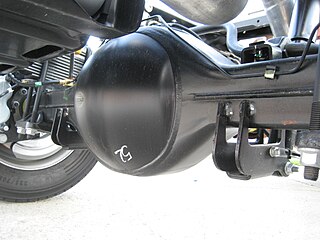 W
WThe Dana/Spicer Model S110 is an automotive axle manufactured by the Dana Holding Corporation and the Eaton Corporation. Eaton manufactures the carrier and Dana manufactures the rest of the axle. The S110 model follows a newer nomenclature for Dana axles. The "S" meaning: single rear axle. The first "1" representing gear reduction type, the second representing the head assembly series and the last "0" representing the design level.
 W
WThe Dunton Campus is a major automotive research and development facility located in Dunton Wayletts, Laindon, Essex, United Kingdom owned and operated by Ford Motor Company. It was the largest automotive technical centre in the United Kingdom and takes its name from the nearby Dunton Wayletts. Ford Dunton houses the main design team of Ford of Europe alongside its Merkenich Technical Centre in Cologne, Germany. With the closure of Ford's Warley site in September 2019, the staff from the UK division of Ford Motor Credit Company and Ford's UK Sales and Marketing departments, have moved to the Dunton site. As of November 2019, Dunton had around 4000 staff working at the site.
 W
WElectric motorsport is a category of motor sport that consists of the racing of electric powered vehicles for competition, either in all-electric series, or in open-series against vehicles with different power trains. Very early in the history of automobiles, electric cars held several performance records over internal combustion engine cars, such as land speed records, but fell behind in performance during the first decade of the 20th century. With the renaissance of electric vehicles during the early 21st century, notable electric-only racing series have been developed, for both cars and motorcycles, including for example, the FIA Formula E Championship. In other racing events, electric vehicles are competing alongside combustion engine vehicles, for example in the Isle of Man TT and the Pikes Peak International Hill Climb, and in some cases winning outright.
 W
WFormula Student is a student engineering competition held annually in the UK. Student teams from around the world design, build, test, and race a small-scale formula style racing car. The cars are judged on a number of criteria as listed below. It is run by the Institution of Mechanical Engineers and uses the same rules as the original Formula SAE with supplementary regulations.
 W
WNIRA Dynamics AB is a Swedish company focusing on research and development of signal processing and control systems for the automotive industry. It supplies automotive original equipment manufacturers (OEMs) and suppliers in Europe, North America, Latin America, and Asia with its products and systems. In 2015, the number of vehicles equipped with NIRA's main product, TPI, exceeded the benchmark of 15,000,000.
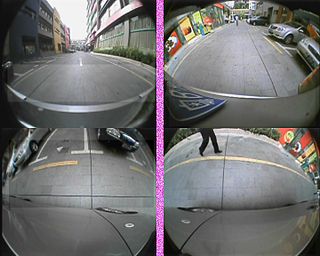 W
WOmniview technology is a vehicle parking assistant technology that first became available in vehicle electronic products in 2007. It is designed to help drivers in parking a vehicle in small space.
 W
WRide height or ground clearance is the amount of space between the base of an automobile tire and the lowest point ; or, more properly, to the shortest distance between a flat, level surface, and the lowest part of a vehicle other than those parts designed to contact the ground. Ground clearance is measured with standard vehicle equipment, and for cars, is usually given with no cargo or passengers.
 W
WThe Sterling 10.5 axle is an automotive axle manufactured by Ford Motor Company at the Sterling Axle Plant in Sterling Heights, MI. It was first used in model year 1985 Ford trucks. The axle was developed to replace the Dana 60 and Dana 70. The Sterling 10.5 axle is currently only made as a full floating axle.
 W
WTeam KART is a group of students from Indian Institute of Technology Kharagpur who like to explore the practical side of automotive engineering.
 W
WUnit construction is the design of larger motorcycles where the engine and gearbox components share a single casing. This sometimes includes the design of automobile engines and was often loosely applied to motorcycles with rather different internal layouts such as the flat twin BMW models.
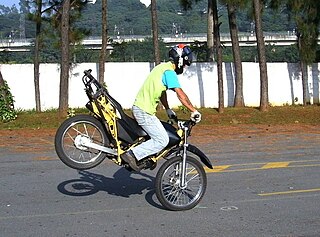 W
WWeight transfer and load transfer are two expressions used somewhat confusingly to describe two distinct effects:the change in load borne by different wheels of even perfectly rigid vehicles during acceleration the change in center of mass (CoM) location relative to the wheels because of suspension compliance or cargo shifting or sloshing
 W
WIn both road and rail vehicles, the wheelbase is the horizontal distance between the centers of the front and rear wheels. For road vehicles with more than two axles, the wheelbase is the distance between the steering (front) axle and the centerpoint of the driving axle group. In the case of a tri-axle truck, the wheelbase would be the distance between the steering axle and a point midway between the two rear axles.
 W
WWreck Racing is a Georgia Tech automotive competition team, based in the Woodruff School of Mechanical Engineering. The team is composed of undergraduate and graduate students from the various schools within Georgia Tech and is based in the Student Competition Center on the North edge of Tech's Atlanta campus. The team's main focus is in the design, fabrication, testing, and racing of production-based sports cars. Wreck Racing primarily competes in the Grassroots Motorsports Annual Challenge, but also has competed in local SCCA and BMWCCA events.